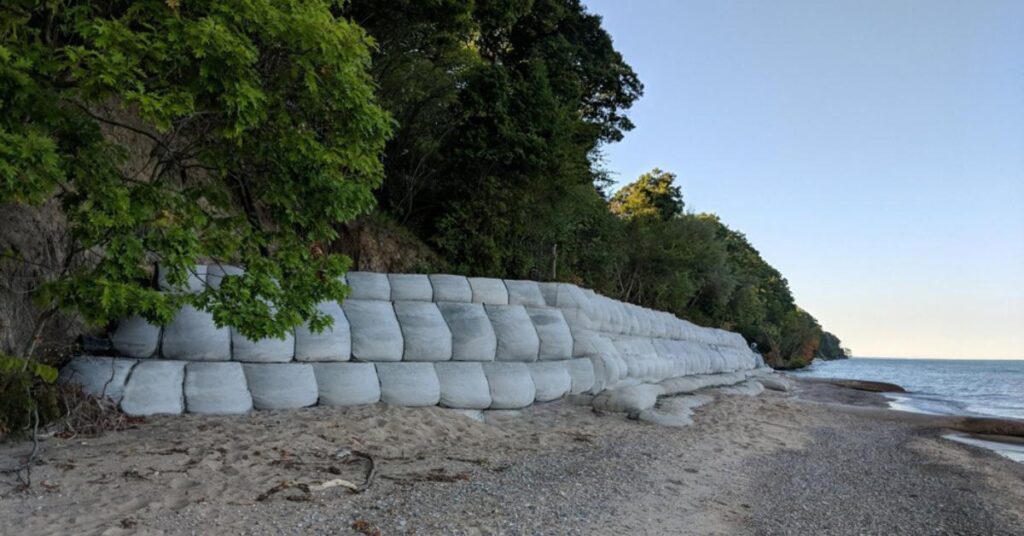How to Build a Water Retaining Wall for Flood Control
An effective water retaining wall can save you thousands in potential damages. TrapBags can serve as affordable solutions for temporary and permanent walls.

A water retaining wall can be a crucial part of your flood control system. An effective wall can prevent significant damage to your property by preventing flooding waters from overflowing and keeping erosion from eating away at the beach or embankment.
What Is a Water Retaining Wall?
For homes or businesses that face bodies of water such as lakes, rivers, or the ocean, a water retaining wall is a way of protecting against a potential flood. Water retaining walls, or seawalls, can be temporarily erected to protect against specific flood situations or permanently installed to prevent overflow for decades.
A water retaining wall can also protect your property from slowly falling away due to erosion. Major storms and hurricanes can break down the natural barriers that protect areas of land along the shore and lead to large amounts of erosion in the weeks afterward.
Will a Retaining Wall Stop Water?
That will depend on how strong the retaining wall is and how strong the floodwaters are. A weak retaining wall may be able to keep back normal water overflow that occurs over the course of seasonal shifts, but it may break down during a heavy storm surge. A strong retaining wall that has been strategically placed and made from well-engineered material can hold back even heavy waves from the ocean.
Should You Build a Water Retaining Wall for Flood Control?
Even if you have never experienced a flood situation on your property before, climate change has been shifting the flood risk map for many people. If you live along a body of water your safest bet is to have a flood control strategy planned out in advance, so you can take action if a potential flood risk arises. Some people only have days or even hours to plan for a flood.
If you live in an area where flood warnings are a common occurrence, you might want to build a permanent water retaining wall. Not only will this hold back flood waters, but it can also prevent erosion as well. Even if you don’t have a regular threat of flooding, it is a good idea to have the supplies and materials available to build a temporary seawall or embankment if you receive a flood warning.
How to Build a Retaining Wall to Hold Back Water
TrapBags provide a cost-effective and efficient way to build a water retaining wall on your property. With the right equipment, a temporary wall can be built using TrapBags within a matter of hours. They can also provide the foundation for a strong permanent wall.
The first thing to do before constructing a permanent retaining wall for flood control is to obtain any necessary permits. While a temporary wall is unlikely to require a permit, permanent walls are usually regulated by the state or local government.
TrapBags can be used to create concrete retaining walls by providing the structure into which the concrete can be poured. A small team can arrange the TrapBags how they see fit, tie them together with a cable, and hold them in place using H-frames. Once the concrete has been poured and dried, the TrapBags can be cut or burned away, leaving behind a perfectly formed barrier. A concrete seawall created with TrapBags can last for several decades depending on the conditions.
People who live in areas that may not need a permanent seawall but who may still experience a flooding situation should have some TrapBags on hand in case they need to build a temporary water retaining wall. TrapBags are designed to be easy to arrange and place, and take up little storage space before they are used.
Where to Place a Water Retaining Wall for Flood Control
Your wall should be placed parallel to the body of water from where you anticipate a potential flood to come from. But you may want to give your wall a slight curve as well. This way, instead of the kinetic energy from the water smashing directly against the wall with its full force, the water will follow the curve of the wall.
Managing a Retaining Wall and Water Drainage
If you build a permanent wall into a hillside or slope on your property, you’ll want to create a wall drainage system to prevent excess water from building up behind the retaining wall. If you don’t, water can slowly begin to undermine the structure underneath the wall and weaken it.
Why Choose TrapBag?
TrapBags have been effectively deployed as seawalls, erosion control systems, and flood barriers.
Unlike sandbags, TrapBags have been specifically designed with a pentagon-shaped structure to create a seawall in which each bag supports the next. Even if one cell of the structure were to become compromised, the rest of the water retaining wall would still remain strong.
This means that TrapBags can be far more efficient than sandbags. In fact, one 100-foot length of 4-foot-tall TrapBags can replace about 4,000 sandbags—and be deployed much faster. They can be filled with sand, dirt, crushed, gravel, or concrete, depending on the situation.
Where Can TrapBags Be Deployed?
TrapBags have been successfully used as water retaining walls on the banks of rivers, lakes, and oceans. They saved homes and businesses in Daytona Beach from being destroyed by beach erosion after the area was hit by both Hurricanes Nicole and Ian. Another homeowner in Michigan created a TrapBag retaining wall to protect their family cottage from being destroyed by erosion from Lake Michigan.
In both of these cases, TrapBags were the optimal choice because of the speed at which they could be deployed. If the residents of Daytona Beach had waited for the permits to fix their seawalls to be approved then they might have lost their homes and businesses. One of the laborers who worked to build the seawall on Lake Michigan said the house would have sustained damage within two weeks if nothing was done. TrapBag was able to create a strong and effective seawall within a matter of hours.
Start Planning Your Water Retaining Wall Today
The friendly and professional staff at TrapBag would be happy to talk with you about how you can build an affordable water retaining wall to protect your property. Let us know your needs and we’ll tell you how TrapBag can help!
Meet the author
Get the Dirt Before the Flood Hits
Stay ahead of flooding, erosion, and disaster response challenges. The Dirt, TrapBag’s monthly newsletter, delivers field-tested tips, real-world case studies, and the latest in barrier technology straight to your inbox.

